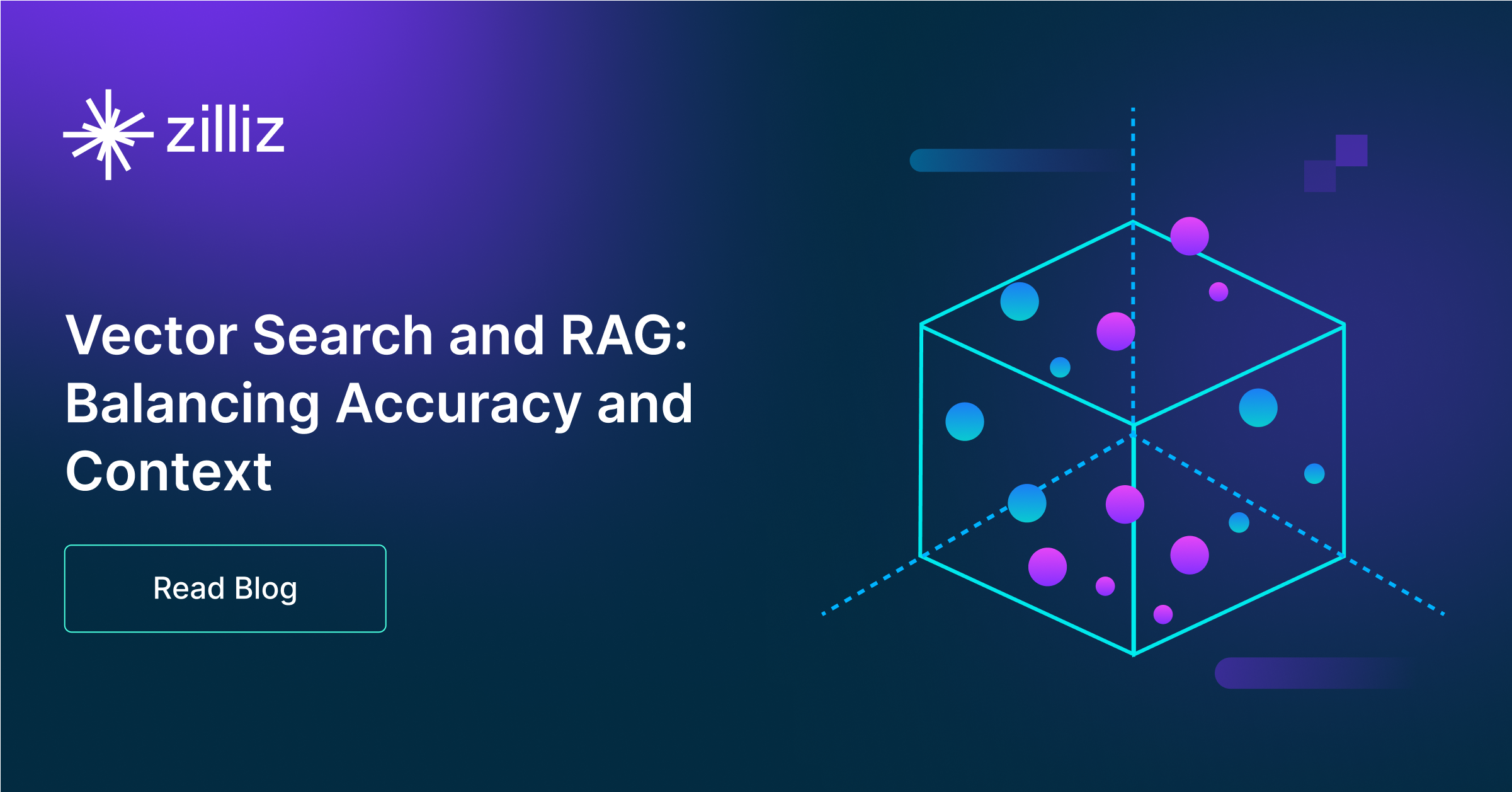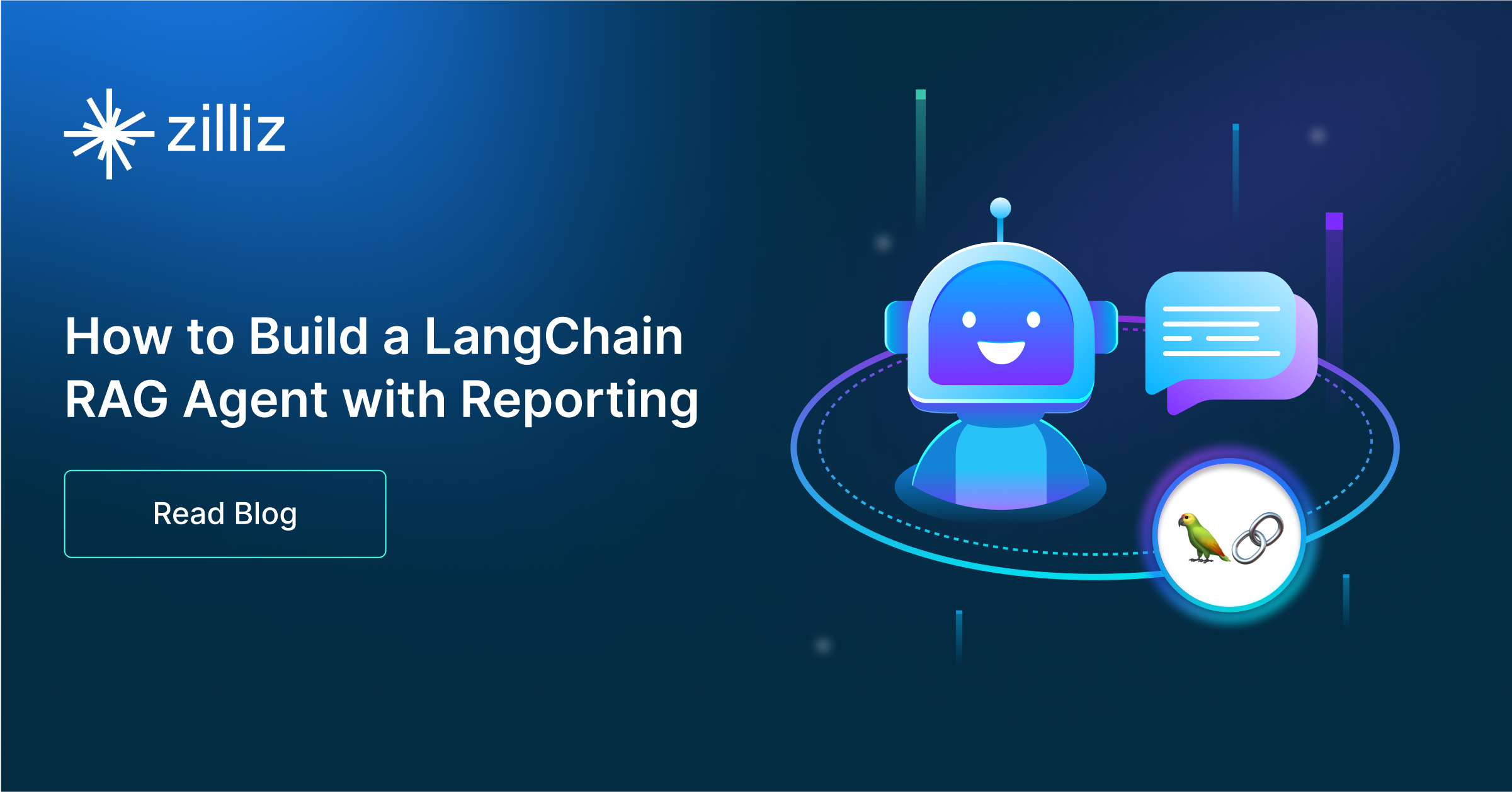Build RAG Chatbot with LangChain, LangChain vector store, Databricks Llama 3.1, and IBM all-minilm-l6-v2
Introduction to RAG
Retrieval-Augmented Generation (RAG) is a game-changer for GenAI applications, especially in conversational AI. It combines the power of pre-trained large language models (LLMs) like OpenAI’s GPT with external knowledge sources stored in vector databases such as Milvus and Zilliz Cloud, allowing for more accurate, contextually relevant, and up-to-date response generation. A RAG pipeline usually consists of four basic components: a vector database, an embedding model, an LLM, and a framework.
Key Components We'll Use for This RAG Chatbot
This tutorial shows you how to build a simple RAG chatbot in Python using the following components:
- LangChain: An open-source framework that helps you orchestrate the interaction between LLMs, vector stores, embedding models, etc, making it easier to integrate a RAG pipeline.
- LangChain in-memory vector store: an in-memory, ephemeral vector store that stores embeddings in-memory and does an exact, linear search for the most similar embeddings. The default similarity metric is cosine similarity, but can be changed to any of the similarity metrics supported by ml-distance. It is intended for demos and does not yet support ids or deletion. (If you want a much more scalable solution for your apps or even enterprise projects, we recommend using Zilliz Cloud, which is a fully managed vector database service built on the open-source Milvusand offers a free tier supporting up to 1 million vectors.)
- Databricks Llama 3.1: This advanced generative model from Databricks focuses on data-centric AI and collaborative analytics. It excels in scalable machine learning tasks, providing robust insights and predictions from large datasets. Ideal for organizations looking to leverage data for automated reporting, interactive data exploration, and enhanced decision-making processes.
- IBM all-minilm-l6-v2: This model is a compact, efficient transformer-based language representation model optimized for tasks requiring fast inferencing. It excels in natural language understanding tasks such as sentiment analysis and information retrieval, making it ideal for applications in chatbots, search engines, and data annotation.
By the end of this tutorial, you’ll have a functional chatbot capable of answering questions based on a custom knowledge base.
Note: Since we may use proprietary models in our tutorials, make sure you have the required API key beforehand.
Step 1: Install and Set Up LangChain
%pip install --quiet --upgrade langchain-text-splitters langchain-community langgraph
Step 2: Install and Set Up Databricks Llama 3.1
pip install -qU "databricks-langchain"
import getpass
import os
if not os.environ.get("DATABRICKS_TOKEN"):
os.environ["DATABRICKS_TOKEN"] = getpass.getpass("Enter API key for Databricks: ")
from databricks_langchain import ChatDatabricks
os.environ["DATABRICKS_HOST"] = "https://example.staging.cloud.databricks.com/serving-endpoints"
llm = ChatDatabricks(endpoint="databricks-meta-llama-3-1-70b-instruct")
Step 3: Install and Set Up IBM all-minilm-l6-v2
pip install -qU langchain-ibm
import getpass
import os
if not os.environ.get("WATSONX_APIKEY"):
os.environ["WATSONX_APIKEY"] = getpass.getpass("Enter API key for IBM watsonx: ")
from langchain_ibm import WatsonxEmbeddings
embeddings = WatsonxEmbeddings(
model_id="sentence-transformers/all-minilm-l6-v2",
url="https://us-south.ml.cloud.ibm.com",
project_id="<WATSONX PROJECT_ID>",
)
Step 4: Install and Set Up LangChain vector store
pip install -qU langchain-core
from langchain_core.vectorstores import InMemoryVectorStore
vector_store = InMemoryVectorStore(embeddings)
Step 5: Build a RAG Chatbot
Now that you’ve set up all components, let’s start to build a simple chatbot. We’ll use the Milvus introduction doc as a private knowledge base. You can replace it with your own dataset to customize your RAG chatbot.
import bs4
from langchain import hub
from langchain_community.document_loaders import WebBaseLoader
from langchain_core.documents import Document
from langchain_text_splitters import RecursiveCharacterTextSplitter
from langgraph.graph import START, StateGraph
from typing_extensions import List, TypedDict
# Load and chunk contents of the blog
loader = WebBaseLoader(
web_paths=("https://milvus.io/docs/overview.md",),
bs_kwargs=dict(
parse_only=bs4.SoupStrainer(
class_=("doc-style doc-post-content")
)
),
)
docs = loader.load()
text_splitter = RecursiveCharacterTextSplitter(chunk_size=1000, chunk_overlap=200)
all_splits = text_splitter.split_documents(docs)
# Index chunks
_ = vector_store.add_documents(documents=all_splits)
# Define prompt for question-answering
prompt = hub.pull("rlm/rag-prompt")
# Define state for application
class State(TypedDict):
question: str
context: List[Document]
answer: str
# Define application steps
def retrieve(state: State):
retrieved_docs = vector_store.similarity_search(state["question"])
return {"context": retrieved_docs}
def generate(state: State):
docs_content = "\n\n".join(doc.page_content for doc in state["context"])
messages = prompt.invoke({"question": state["question"], "context": docs_content})
response = llm.invoke(messages)
return {"answer": response.content}
# Compile application and test
graph_builder = StateGraph(State).add_sequence([retrieve, generate])
graph_builder.add_edge(START, "retrieve")
graph = graph_builder.compile()
Test the Chatbot
Yeah! You've built your own chatbot. Let's ask the chatbot a question.
response = graph.invoke({"question": "What data types does Milvus support?"})
print(response["answer"])
Example Output
Milvus supports various data types including sparse vectors, binary vectors, JSON, and arrays. Additionally, it handles common numerical and character types, making it versatile for different data modeling needs. This allows users to manage unstructured or multi-modal data efficiently.
Optimization Tips
As you build your RAG system, optimization is key to ensuring peak performance and efficiency. While setting up the components is an essential first step, fine-tuning each one will help you create a solution that works even better and scales seamlessly. In this section, we’ll share some practical tips for optimizing all these components, giving you the edge to build smarter, faster, and more responsive RAG applications.
LangChain optimization tips
To optimize LangChain, focus on minimizing redundant operations in your workflow by structuring your chains and agents efficiently. Use caching to avoid repeated computations, speeding up your system, and experiment with modular design to ensure that components like models or databases can be easily swapped out. This will provide both flexibility and efficiency, allowing you to quickly scale your system without unnecessary delays or complications.
LangChain in-memory vector store optimization tips
LangChain in-memory vector store is just an ephemeral vector store that stores embeddings in-memory and does an exact, linear search for the most similar embeddings. It has very limited features and is only intended for demos. If you plan to build a functional or even production-level solution, we recommend using Zilliz Cloud, which is a fully managed vector database service built on the open-source Milvus and offers a free tier supporting up to 1 million vectors.)
Databricks Llama 3.1 optimization tips
Databricks Llama 3.1 is designed for scalable and high-performance RAG applications, making it crucial to optimize retrieval and processing efficiency. Leverage Databricks' distributed computing capabilities to parallelize retrieval and embedding computations, reducing latency for large datasets. Implement hybrid search (combining vector and keyword search) to enhance retrieval relevance. Use optimized prompt templates to minimize token usage while maximizing response quality. Fine-tune temperature (0.1–0.3) for factual consistency and adjust top-k/top-p for response control. Cache frequently queried results to reduce redundant computations, improving both cost and performance. If dealing with large-scale queries, utilize Databricks’ auto-scaling to dynamically allocate resources and avoid bottlenecks. Implement incremental indexing for real-time updates to your vector store, ensuring retrieval accuracy remains high over time.
IBM all-minilm-l6-v2 optimization tips
To optimize the performance of IBM all-minilm-l6-v2 in a Retrieval-Augmented Generation (RAG) setup, consider implementing streamlined query preprocessing to remove stop words and normalize text, ensuring that input queries are concise and relevant. Layering caching strategies on frequently retrieved results can significantly reduce latency, while fine-tuning the model with domain-specific data enhances relevance and accuracy. Additionally, experiment with batch processing during inference to leverage parallelization, and monitor and adjust hyperparameters like learning rates and maximum token counts to refine model responses. Lastly, ensure that your retrieval system is seamlessly integrated with the generation process to maintain context and coherence in generated outputs.
By implementing these tips across your components, you'll be able to enhance the performance and functionality of your RAG system, ensuring it’s optimized for both speed and accuracy. Keep testing, iterating, and refining your setup to stay ahead in the ever-evolving world of AI development.
RAG Cost Calculator: A Free Tool to Calculate Your Cost in Seconds
Estimating the cost of a Retrieval-Augmented Generation (RAG) pipeline involves analyzing expenses across vector storage, compute resources, and API usage. Key cost drivers include vector database queries, embedding generation, and LLM inference.
RAG Cost Calculator is a free tool that quickly estimates the cost of building a RAG pipeline, including chunking, embedding, vector storage/search, and LLM generation. It also helps you identify cost-saving opportunities and achieve up to 10x cost reduction on vector databases with the serverless option.
 Calculate your RAG cost
Calculate your RAG cost
What Have You Learned?
By now, you’ve seen how the magic of LangChain, vector databases, LLMs, and embedding models come together to create a powerful RAG system! You learned how LangChain acts as the glue, orchestrating workflows between components seamlessly. The LangChain vector store became your go-to for lightning-fast retrieval, turning unstructured data into searchable knowledge. Then, IBM’s all-minilm-l6-v2 stepped in as the embedding model hero, transforming text into dense vectors that capture meaning—like a supercharged language GPS. And let’s not forget Databricks’ Llama 3.1, the LLM powerhouse that synthesized retrieved information into human-like responses, proving that context-aware AI isn’t just possible—it’s accessible. Together, these tools formed a pipeline that breathes life into documents, turning static data into dynamic, interactive insights.
But wait—there’s more! You also picked up pro tips for optimizing performance, like tweaking chunk sizes and refining prompts to squeeze every ounce of quality from your system. And that free RAG cost calculator? A game-changer for balancing accuracy with budget, ensuring your projects stay scalable and cost-effective. Imagine what you can build now: chatbots that actually understand niche topics, research assistants that dig through papers in seconds, or customer support tools that feel human. The skills you’ve gained aren’t just theoretical—they’re a launchpad. So go ahead! Experiment with different models, fine-tune your retrieval strategies, and push the boundaries of what’s possible. The future of intelligent applications is in your hands—start crafting it today, one RAG-powered innovation at a time. 🚀
Further Resources
🌟 In addition to this RAG tutorial, unleash your full potential with these incredible resources to level up your RAG skills.
- How to Build a Multimodal RAG | Documentation
- How to Enhance the Performance of Your RAG Pipeline
- Graph RAG with Milvus | Documentation
- How to Evaluate RAG Applications - Zilliz Learn
- Generative AI Resource Hub | Zilliz
We'd Love to Hear What You Think!
We’d love to hear your thoughts! 🌟 Leave your questions or comments below or join our vibrant Milvus Discord community to share your experiences, ask questions, or connect with thousands of AI enthusiasts. Your journey matters to us!
If you like this tutorial, show your support by giving our Milvus GitHub repo a star ⭐—it means the world to us and inspires us to keep creating! 💖
- Introduction to RAG
- Key Components We'll Use for This RAG Chatbot
- Step 1: Install and Set Up LangChain
- Step 2: Install and Set Up Databricks Llama 3.1
- Step 3: Install and Set Up IBM all-minilm-l6-v2
- Step 4: Install and Set Up LangChain vector store
- Step 5: Build a RAG Chatbot
- Optimization Tips
- RAG Cost Calculator: A Free Tool to Calculate Your Cost in Seconds
- What Have You Learned?
- Further Resources
- We'd Love to Hear What You Think!
Content
Vector Database at Scale
Zilliz Cloud is a fully-managed vector database built for scale, perfect for your RAG apps.
Try Zilliz Cloud for Free


